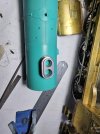Nick Dunhill
Western Thunderer
All very interesting. I bet the thick boss was so the eccentric rods cleared the fixing studs on the return crank.
I've had to do all this without the benefit of a drawing, although it doesn't always help having one. Often in FS there's some design compromises as the wheels aren't prototypical positioning, and the cylinders are. Sometimes, the kit design is such that the con rods are designed to slope in (which I think was the case here, see con rod bosses above.) This would have generated more space for the oversize return cranks. The expansion link was also way too thick, and was modified quite heavily.
The expansion links in kits are often very simplified, and don't allow the radius rod to move. The radius rod is often fixed to the expansion link pivot, and the loco is permanently in 'neutral.' (Sorry not sure what the correct expression is.) This was the case here. I don't have the budget to alter thus, but I did drill another hole in the expansion link to fix the radius rod so the loco is in forward position.
I've had to do all this without the benefit of a drawing, although it doesn't always help having one. Often in FS there's some design compromises as the wheels aren't prototypical positioning, and the cylinders are. Sometimes, the kit design is such that the con rods are designed to slope in (which I think was the case here, see con rod bosses above.) This would have generated more space for the oversize return cranks. The expansion link was also way too thick, and was modified quite heavily.
The expansion links in kits are often very simplified, and don't allow the radius rod to move. The radius rod is often fixed to the expansion link pivot, and the loco is permanently in 'neutral.' (Sorry not sure what the correct expression is.) This was the case here. I don't have the budget to alter thus, but I did drill another hole in the expansion link to fix the radius rod so the loco is in forward position.
Last edited:



 All the cast parts fit, when you work out where they go, and the etches are good but none of the numbers match the instructions!
All the cast parts fit, when you work out where they go, and the etches are good but none of the numbers match the instructions!




















